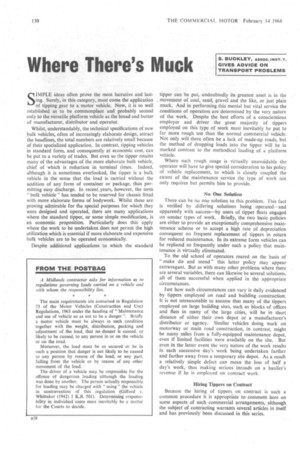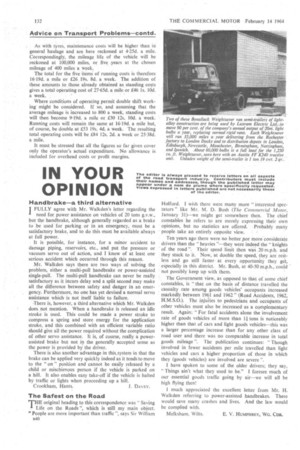Where There's Muck
Page 132

Page 133

Page 134

If you've noticed an error in this article please click here to report it so we can fix it.
SIMPLE ideas often prove the most lucrative and lasting. Surely, in this category, must come the application of tipping gear to a motor vehicle. NOw, it is so well established as to be commonplace and probably second only to the versatile platform vehicle as the bread and butter of manufacturer, distributor and operator.
Whilst, understandably, the technical specifications of new bulk vehicles, often of increasingly elaborate design, attract the headlines, the total numbers are relatively small because of their specialized application. In contrast, tipping vehicles in standard form, and consequently at economic cost, can be put to a variety of trades. But even so the tipper retains many of the advantages of the more elaborate bulk vehicle, chief of which is reduction in terminal times. Indeed, although it is sometimes overlooked, the tipper is a bulk vehicle in the sense that the load is carried without the addition of any form of container or package, thus permitting easy discharge. In recent.years, however, the term "bulk vehicle" has tended to be reserved for chassis fitted with more elaborate forms of bodywork. Whilst these are proving admirable for the special purposes for which they were designed and operated, there are many applications where the standard tipper, or some simple modification, is an economic proposition. Particularly does this apply where the work to be undertaken does not permit the high utilization which is essential if more elaborate and expensive bulk vehicles are to be operated economically.
Despite additional applications to which the standard
tipper can be put, undoubtedly its greatest asset is in the movement of coal, sand, gravel and the like, or just plain muck. And in performing this menial but vital service the conditions of operation are determined by the very nature of the work. Despite the best efforts of a conscientious employer and driver the great majority of tippers employed on this type of work must inevitably be put to far more rough use than the normal commercial vehicle. Not only will there often be a lack of made-up roads, but the method of dropping loads into the tipper will be in marked contrast to the methodical loading of a platform vehicle.
Where such rough usage is virtually unavoidable the operator will have to give special consideration to his policy of vehicle replacement, to which is closely coupled the extent of the maintenance service the type of work not only requires but permits him to provide.
No One Solution There can be no one solution to this problem. This fact is verified by differing solutions being operated—and apparently with success—by users of tipper fleets engaged on similar types of work. Briefly, the two basic policies are either to provide an exceptionally comprehensive maintenance scheme or to accept a high rate of depreciation consequent on frequent replacement of tippers in return for reduced maintenance. In its extreme form vehicles can be replaced so frequently under such a policy that maintenance is virtually eliminated.
To the old school of operators reared on the basis of "make do and mend" this latter policy may appear extravagant. But as with many other problems where there are several variables, there can likewise be several solutions, all of them successful when applied in the appropriate circumstances.
Just how such circumstances can vary is daily evidenced by tippers employed on road and building construction. It is not unreasonable to assume that many of the tippers employed on large building sites, such as blocks of offices and flats in many of the large cities, will be in short distance of either their own depot or a manufacturer's distributor or agency. Similar vehicles doing work on motorway or main road construction, in contrast, might be many miles from a fully-equipped maintenance depot, even if limited facilities were available on the site. But even in the latter event the very nature of the work results in each successive day's work being undertaken farther and farther away from a temporary site depot. As a result a relatively simple defect can mean the loss of half a day's work, thus making serious inroads on a haulier's revenue if he is employed on contract work.
Hiring Tippers on Contract
Because the hiring of tippers on contract is such a common procedure it is appropriate to comment here on sonic aspects of such commercial arrangements, although the subject of contracting warrants several articles in itself and has previously been discussed in this series.
Whether or not there is political agreement as to the extent and progress of a national road policy there will undoubtedly be a great amount of road construction and improvement for many years to come. Similarly there will be a greater demand for tippers and their supply on contract.
Unfortunately, as recent strictures by licensing authorities have revealed, there can be abuses of both regulations and elementary regard of road transport economies when the possibility of large contracts are in the offing. On such occasions the very large tonnages requiring to be moved imply lucrative work for the taking. Quantity alone, however, is not a guarantee of profitability. The reverse can well be true once a contract is signed and sealed.
An operator engaged in general haulage may, on occasion, make a quotation and subsequently move a particular consignment at a loss, possibly because of some unforeseen delay or difficulty at terminal points. Despite this loss he will at least have added to his experience and is not likely to make the same mistake again. However, the haulier operating on contract, once committed, has to continue with his part of the bargain even if he soon finds out that he has made a miscalculation either in his costing or his assessment• of the work involved. It is therefore doubly necessary that a tipper operator tendering for work on contract should make sure that his quotation is sound.
Cost of Operations As an example of the manner in which the cost of operating a tipper can be calculated, the following details are given with the qualification that, as already mentioned, conditions of work can vary substantially—much more so than in general haulage. Obviously, costs of operation will vary likewise.
A notable trend in recent years has been the increasing range offered by the manufacturers of quantity-produced-vehicles. Once the upper limit of goods vehicle in this category was around five tons. Now, together with the additional availability of the oil engine, vehicles of 'nand 8-ton capacity are available. An 8-ton tipper in this range with 7-cu.-yd. capacity is chosen here. With oil engine the cost, new, is assumed to be £2,100.
Fitted with drop-side tipper body the unladen weight is reckoned as 4 tons 10 cwt., so incurring an annual licence duty of £72. With the addition of the appropriate amount for a carrier's A licence fee, the equivalent standing cost per week in respect of licences will then be LI 9s. 8d, As with the other four items of standing costs, this latter calculation is based on a 50-week year, so allowing for two weeks per annum when the vehicle may be off the road for annual holidays or major overhaul.
The total cost of wages to the employer for a basic 42-hour week (as at present applies) is reckoned at £11 10s. 8d. This amount includes the employer's National Insurance contribution and an appropriate adjustment to allow for holidays with pay. In this instance it also includes the 4 per cent increase recently recommended by the Road Haulage Wages Council, although not yet authorized by the Minister of Labour.
Rent and rates in respect of garaging the vehicle are assessed at £1 2s. 3d. a week, whilst vehicle insurance adds £2 17s. 7d: a week. This assumes that the vehicle is based in a. medium-risk area and is appropriate to its cost and capacity.
Interest charged at a nominal rate of five per cent on the initial outlay of £2,100 adds £2 2s. a week to the standing costs, so giving a total for these five items of £19 2s. 2d. a week.
The maximum advantage of the principle of tipper operation is obviously obtained in the type of work involving several deliveries. This in turn implies relatively short loads and so a low average weekly mileage. Whilst there are obviously exceptions it will be assumed here that the weekly mileage is 400. As a result the standing costs per mite will be 11.46d.
In normal use this class of oil-erigined 8-tonner will have a rate of fuel consumption of 14 m.p.g. But when engaged on tipper work this will be reduced to 10 m.p.g. With fuel purchased in bulk at 4s, 21-d, a gallon the fuel cost per mile will be 5.03d. Lubricants add 0.28d. a mile.
A set of tyres will cost around £218, but because of the probable arduous conditions of use an average life per set of only 20,000 miles will be assumed. Incidentally, in assessing average mileage per set, whether in general haulage or tipper work, the premature discarding of at least one tyre in a set—a relatively common occurrence— is often omitted when calculating tyre costs. As with tyres, maintenance costs will be higher than in general 'haulage and are here reckoned at 4-25d. a mile. Correspondingly, the mileage life of the vehicle will be reckoned at 100,000 miles, or five years at the chosen mileage of 400 miles a week.
The total for the five items of running costs is therefore 16-19d. a mile or £26 19s. 8d. a week. The addition of these amounts to those already obtained as standing costs gives a total operating cost of 27-65d. a mile or £46 Is. 10d. a week.
Where conditions of operating permit double shift working might be considered. If so, and assuming that the average mileage is increased to 800 a week, standing costs will then become 9-19d. a mile or £30 12s. 10cL a week. Running costs will remain the same at 16-19d. a mile but, of course, be double at £53 19s. 4d. a week. The resulting total operating costs will be £84 12s. 2d. a week or 25-38d. a mile.
It must be stressed that all the figures so far given cover only the operator's actual expenditure. No allowance is included for overhead costs or profit margins.
















































































































































































